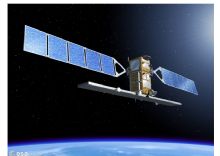Sentinel-1 is the first of the Copernicus Programme satellite constellation conducted by the European Space Agency. This mission is composed of a constellation of two satellites, Sentinel-1A and Sentinel-1B, which share the same orbital plane. They carry a C-band synthetic-aperture radar instrument which provides a collection of data in all-weather, day or night. This instrument has a spatial resolution of down to 5 m and a swath of up to 400 km. The constellation is on a sun synchronous, near-polar (98.18°) orbit. The orbit has a 12-day repeat cycle and completes 175 orbits per cycle.
The first satellite, Sentinel-1A, launched on 3 April 2014, and Sentinel-1B was launched on 25 April 2016. Both satellites lifted off from the same location in Kourou, French Guiana, and each on a Soyuz rocket.

The SENTINEL-1 SAR instrument and short revisit time will greatly advance users’ capabilities and provide data routinely and systematically for maritime and land monitoring, emergency response, climate change and security.
Each SENTINEL-1 satellite is expected to transmit Earth observation data for at least 7 years and have fuel on-board for 12 years.
Applications:
A summary of the main applications of Sentinel-1 include:
- Marine monitoring
- Sea-ice levels and conditions
- Ocean oil spills
- Ship activity
- Marine winds
- Land monitoring
- Agriculture
- Forestry
- Subsidence
- Emergency response
- Flooding
- Landslide and volcanic
- Earthquakes
For more information: https://sentinel.esa.int/web/sentinel/missions/sentinel-1
SENTINEL-1 TECHNICAL SPECIFICATIONS:
|
Parameter |
Sentinel-1 |
|
Launch date |
April 03, 2014 of S1-A |
|
Orbit type |
SSO (Sun-synchronous Orbit) 12 day repeat cycle LTAN = 18:00 hours |
|
Orbital altitude |
693 km |
|
Sensor complement |
C-SAR (C-band Synthetic Aperture Radar) |
|
Spacecraft mass Spacecraft size Spacecraft power |
2300 kg 3.4 m x 1.3 m x 1.3 m 4.8 kW (EOL) |
|
Downlink X-band data rate |
520 Mbit/s |
|
TT&C S-band |
64 kbit/s uplink 128 kbit/s or 2 Mbit/s downlink |
|
Science data storage |
1.4 Tbit (EOL) |
|
Required data quality |
BER (Bit Error Rate): < 10-9 |
|
Operational autonomy |
8 days |
|
Prime contractor |
TAS-I (Thales Alenia Space-Italy) |
|
Baseline launcher |
Soyuz (Kourou) |
